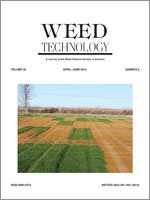In the Pacific Northwest, downy brome continues to infest winter wheat, especially in low-rainfall areas where the winter wheat–summer fallow rotation is the dominant production system. In Washington, a study was conducted for 2 yr at two locations in the winter wheat–summer fallow region to determine the influence of four postharvest tillage treatments on vertical seed movement, seedbank depletion, and plant densities of downy brome. The four tillage implements included a disk, sweep plow, harrow, and skew treader. The study also included a no-till treatment for comparison. The sweep plow and disk led to the most vertical movement of downy brome seed compared with the no-till treatment. Approximately 75% of the fall postharvest seed in the no-till treatment was located either on the soil surface or in the 0- to 3-cm depth at both locations. In contrast, 75% of the seed in the disked treatment was located from 0 to 6 cm deep at both locations. The disk and sweep plow both decreased downy brome seed in the soil at the 0- to 3-cm depth compared with the harrow and no-till treatments. There was no difference in downy brome plant densities following postharvest tillage in the summer fallow due to any of the treatments. However, plant densities in the subsequent winter wheat crop were reduced by the disk and sweep plow compared with the no-till and skew-treader treatments. In general, seed densities as affected by the skew treader fell between the disk and the no-till treatments. The use of the sweep plow and the disk should be integrated into a weed management strategy for downy brome in the wheat–fallow region of the Pacific Northwest.
Nomenclature: Downy brome; Bromus tectorum L.; winter wheat; Triticum aestivum L.
En el Pacífico Noroeste, Bromus tectorum continúa infestando campos de trigo de invierno, especialmente en áreas con baja precipitación donde la rotación de trigo de invierno y barbecho de verano es el sistema dominante de producción. En Washington, se realizó un estudio por 2 años, en dos localidades en la región de rotación trigo de invierno y barbecho en verano, para determinar la influencia de cuatros tratamientos de labranza pos-cosecha sobre el movimiento vertical de la semilla, agotamiento del banco de semillas, y la densidad de plantas de B. tectorum. Los cuatro implementos de labranza fueron una rastra de discos, un cultivador de cuchilla, un cultivador de cincel, y un cultivador rotativo de dientes oblicuos. El estudio también incluyó un tratamiento de labranza cero para fines de comparación. El cultivador de cuchilla y la rastra de discos produjo el mayor movimiento vertical de semilla de B. tectorum al compararse con el tratamiento de labranza cero. Después de la cosecha en el otoño, aproximadamente 75% de la semilla en el tratamiento de labranza cero se localizó en la superficie del suelo o a una profundidad de 0 a 3 cm en ambas localidades. En cambio, 75% de la semilla en el tratamiento de rastra de discos se localizó de 0 a 6 cm de profundidad en ambas localidades. La rastra de discos y el cultivador de cuchillas disminuyeron la semilla de B. tectorum en el suelo de 0 a 3 cm de profundidad al compararse con los tratamientos de cultivador de cincel y la labranza cero. No hubo diferencia en la densidad de plantas de B. tectorum después de la labranza pos-cosecha en el barbecho de verano producto de los tratamientos. Sin embargo, la densidad de plantas en el siguiente cultivo de trigo de invierno se redujo con la rastra de discos y el cultivador de cuchillas al compararse con los tratamientos de labranza cero y el cultivador rotativo de dientes obl





